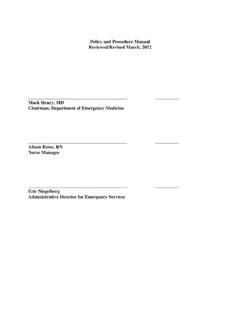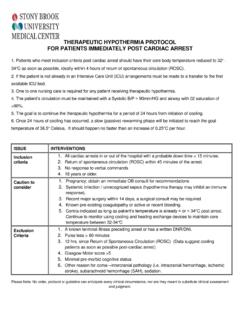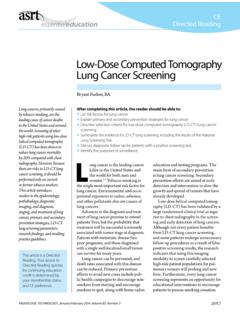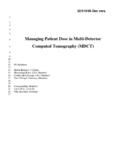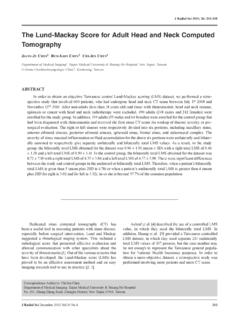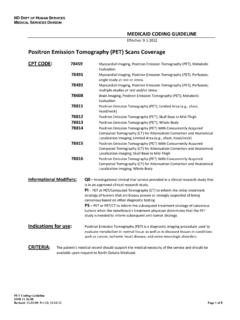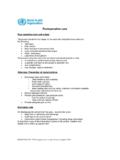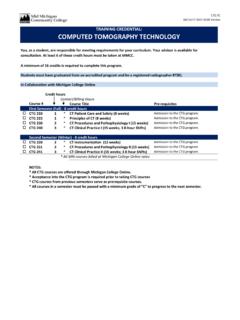Transcription of Implanted Ports, Computed Tomography, Power ...
1 Clinical Journal of Oncology Nursing Volume 12, Number 5 Safety 809 Lisa Hartkopf Smith, RN, MS, AOCN , CNS, is a hematology-oncology clinical nurse specialist at Riverside Methodist Hospital in Columbus, OH. Mention of specific products and opinions related to those products do not indicate or imply endorsement by the Clinical Journal of Oncology Nursing or the Oncology Nursing Object Identifier: ports , Computed tomography , Power Injectors, and Catheter RuptureSa f e t y Li S a Ha r t k o p f Sm i tH, rN, mS, aoCN , CNS aS S o C i a t e ed i t o rLisa Hartkopf Smith, RN, MS, AOCN , CNSPat ient s w it h ca ncer of ten requ i re com-puted tomography (CT) examinations to monitor the status of their disease. To en-hance CT images, radiology personnel use Power injectors to administer radiopaque contrast media at high pressures and con-trolled rates.
2 If Power injectors are used with Implanted ports that are not designed to withstand pressures generated by the injectors, catheter ruptures can occur. Catheter rupture can lead to extravasation of vesicant contrast dye, catheter fragment emboli in the right atrium or pulmonary artery, and the need for port removal and replacement ( Food and Drug Admin-istration [FDA], 2006). Several vascular access manufacturers have recently de-veloped Implanted ports that are safe for Power injection. For patients who may already have poor peripheral venous ac-cess, the ability to use their port to inject contrast media decreases discomfort from venipuncture and helps lower the risk for extravasation of vesicant contrast Power injectable ports have many benefits, serious adverse events can occur if safety processes are not developed and implemented.
3 Oncology nu r ses ca n prevent cat heter r upt u re by ac-curately identifying a port that is a Power injectable port; using the correct Power injectable, pressure-tested port needle to access the port; communicating with radiology personnel; and educating the patient about port safety 2004, the FDA reported receiving more than 250 adverse event reports in which vascular access devices ruptured when Power injectors were used to give contrast media as part of CT or magnetic resonance imaging studies (FDA, 2004).The events involved central venous cath-eters (including Implanted ports ), small-gauge peripheral catheters, extension tubings, and IV tubings. The catheter ruptures caused extravasation of vesicant contrast media, loss of catheter function, and the need for additional surgery to replace the line.
4 In some cases, catheter rupture caused the catheter to fragment and embolize. The issue continued to occur despite warnings, resulting in ad-ditional FDA alerts (FDA, 2006). Catheter Rupture and Fragment EmbolizationPublished case reports of Implanted por t cat heter r upt u re h ave descr ibed cat h-eter f r a g ment emb ol i z at ion a s b ei ng a n i n-cidental finding with few harmful effects (Liu, Tseng, Chen, Chern, & Chang, 2004). However, ot her aut hor s h ave repor ted t he occurrence of severe complications to be as high as 71% (Fisher & Ferreyro, 1978). In a study by Surov et al. (2008) examin-ing 41 Implanted port catheter fractures, most catheter fragments were found in the pulmonary artery, superior vena cava, and right atrium.
5 The most common symptom of catheter embolization was port mal-function (39%). Of the patients in whom the catheter fragments were located in the right atrium, right ventricle, and pulmo-nary artery, presented with cardiac symptoms. Complications included partial occlusion of the pulmonary artery, ar-rthymias, pulmonary thromboembolism, pulmonary hypertension, and right ven-tricular failure. In of cases, catheter embolism was found causing pressure with resul-tant catheter rupture of the vascular access device or IV tubing included the flow rate of the Power injector, catheter diameter and length, the viscosity of the contrast material, and obstruction to the flow of the contrast media (FDA, 2004).
6 Obstructed flow in Implanted ports can occur from fibrin, drug precipitates, catheter malposition, and the pinch-off syndrome. The pinch-off syndrome (also called costoclavicular pinching) refers to the process in which catheter compres-sion between the clavicle and first rib over a prolonged period of time causes mechanical friction that weakens the catheter (Schulmeister, 2005). When the catheter is compressed, the risk for cath-eter rupture and fracture increases. The pinch-off syndrome has been reported to be the most common cause of catheter fracture (Surov et al., 2008). The FDA s (2006) recommendations to prevent catheter fracture from occurring include checking the label of each vascular access device for its maximum pressure and flow rate, knowing the pressure limit setting for the Power injector and how to adjust it, and verifying that the pressure 810 October 2008 Volume 12, Number 5 Clinical Journal of Oncology Nursinglimit setting for the Power injector does not exceed the maximum labeled pressure on the vascular access device.
7 Power Injectable Implanted PortsManufacturers have developed a vari-ety of vascular access devices that can withstand the pressures generated by CT scan Power injectors (5 mls/ Power injection at 300 psi pressure limit set-ting). These devices include peripherally inserted central catheters, temporary external catheters, and Implanted ports . Examples of Power injectable ports in-clude the PowerPORT Implanted Port (Bard Access Systems), the Smart Port (AngioDynamics, Inc), and the Port-A-Cath II Power (Smiths Medical). To date, only single lumen Power inject-able ports are available in the United States. Power injectable ports come in different profiles and different materi-als ( , plastic, titanium).
8 Some recent models have CT on the base of the port, which can be seen on x-rays or CT scans to help in port PowerPORT Implanted Port is unique in that the port is a triangle shape and has three bumps located on the port septum (see Figure 1). The triangular shape and the bumps can be palpated and are used to assist in identification of the port as a PowerPORT Implanted Port prior to accessing the port with a noncoring needle. All other currently available Power injectable ports are round in shape, similar to most nonpower injectable ports . Power Injectable Port NeedlesPower injectable ports are accessed and used according to the same proce-dures as nonpower injectable ports , with the only difference being the type of port needle used.
9 Standard port needle tubings cannot withstand the pressures of the CT Power injector; therefore, pressure-tested port needles must be used. Examples of Power injectable port needles include the Gripper Plus Power P. A .C . Sa fet y Huber Need le ( Sm it h s Med i-cal) and the PowerLoc Safety Infusion Set (Bard Access Systems). Power inject-able port needles are labeled and some are color coded. Instead of only stocking Power injectable port needles, many institutions keep both Power injectable port needles and nonpower injectable port needles. Placing a Power injectable port needle into a non- Power injectable port could be considered mislabeling of the port. Maximum f low rates for 19-gauge, 20-gauge, and 22-gauge Power i njec t able need les a re 5 m l /s econd, 5 m l /second, and 2 ml/second (respectively), and the maximum pressure setting for the Gripper Plus Power Safety Huber Needle and the PowerLoc Safety Infusion Set is 300 psi.
10 Identifying Power Injectable PortsExternal Power injectable venous ac-cess devices such as peripherally inserted central catheters can be identified easily by color coding and labeling on the catheter. However, Implanted ports are challenging to identify because the port is underneath the skin. Implanted ports can remain in place for many years if needed and if no complications occur; therefore, hospitals and outpatient settings may have patients with Power injectable and nonpower ports . Because of identification issues and the potential for Implanted port catheter rupture, healthcare providers must de-velop a safe system to accurately identify ports at the time of access and immediately prior to Power injection (see Figure 2).

